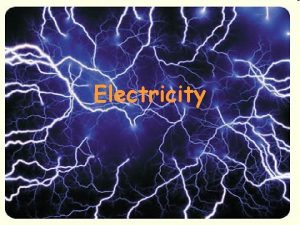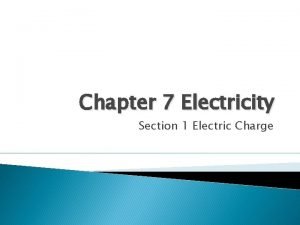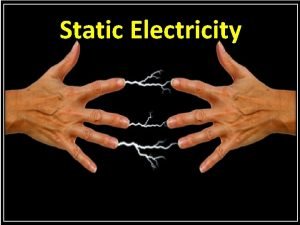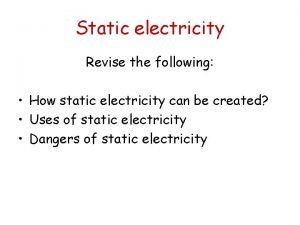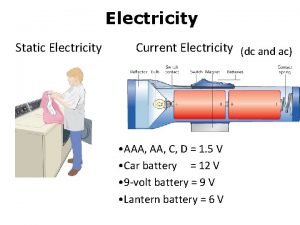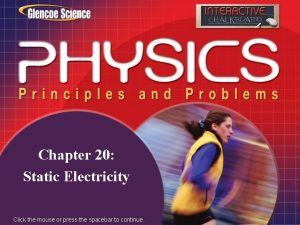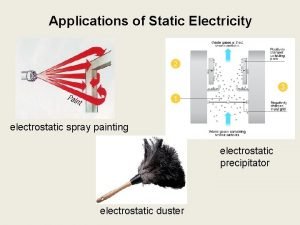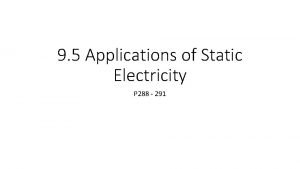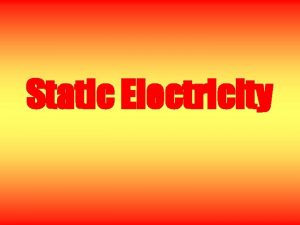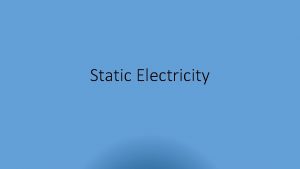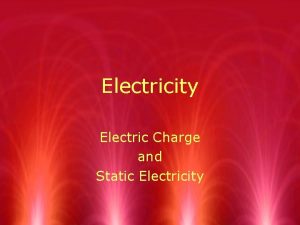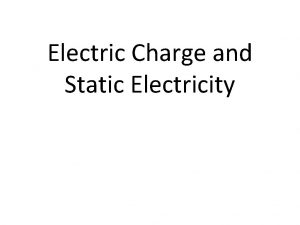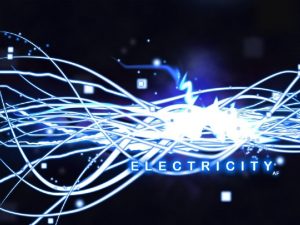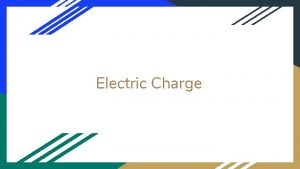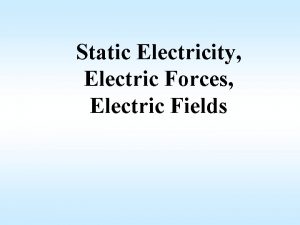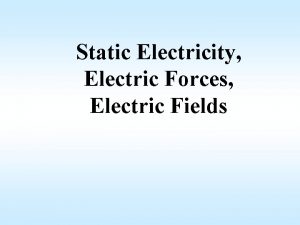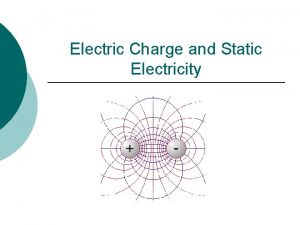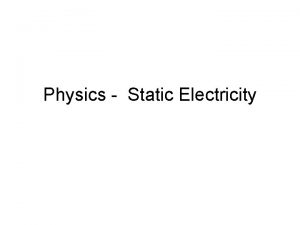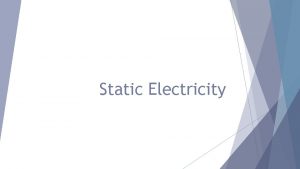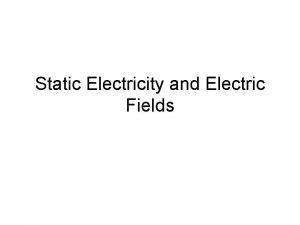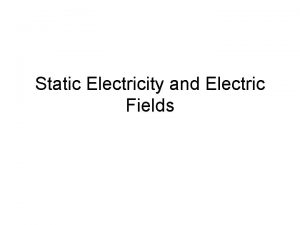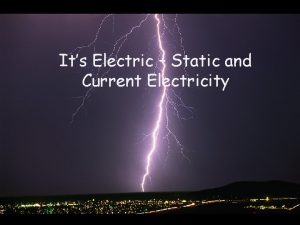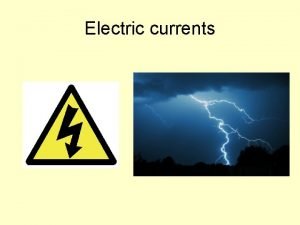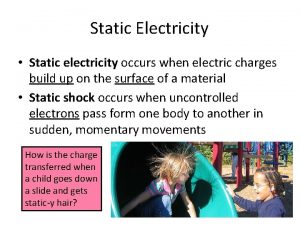Electric Charge and Static Electricity Electric Charge 1





















- Slides: 21

Electric Charge and Static Electricity

Electric Charge ¡ ¡ 1. 2. 3. All matter is made up of atoms Atoms contain Protons (+) Neutrons (0) Electrons (-)

Law of Electric Charges ¡ The law of electric charges states that like charges repel, and opposite charges attract. ¡ Protons are positively charged and electrons are negatively charged, so they are attracted to each other. ¡ Without this attraction, electrons would not be held in atoms.

Law of Electric Charges

Electric Force The force between the charged objects is an electric force. The size of the electric force depends on 2 things: 1. 2. The amount of charge (the greater the charge, the greater the force) The distance between charges (the further the distance, the less the force)

Electric Field An electric field is the region around a charged object where electric forces can be exerted on another charged object. (Repelled or attracted) ¡

Charged Objects Atoms do not have a charge because the number of electrons and protons cancel each other out. Ex. 3 protons (+) & 3 electrons (-) = 0 ¡

Charged Objects How do objects get charged? ¡ They either gain or lose electrons. ¡ Why not protons? Ex. 3 protons (+) & 5 electrons (-) = 7 protons (+) & 2 electrons (-) =

How Can You Charge Objects? ¡ There are 3 ways objects can be charged: 1. 2. 3. Friction Conduction Induction **In each of these, only the electrons move. The protons stay in the nucleus**

Friction ¡ Charging by friction occurs when electrons are “wiped” from one object onto another. Ex. If you use a cloth to rub a plastic ruler, electrons move from the cloth to the ruler. The ruler gains electrons and the cloth loses electrons.

Conduction ¡ Charging by conduction happens when electrons move from one object to another through direct contact (touching). Ex. Suppose you touch an uncharged piece of metal with a positively charged glass rod. Electrons from the metal will move to the glass rod. The metal loses electrons and becomes positively charged.

Induction ¡ Charging by induction happens when charges in an uncharged object are rearranged without direct contact with a charged object. Ex. If you charge up a balloon through friction and place the balloon near pieces of paper, the charges of the paper will be rearranged and the paper will be attracted to the balloon.

Conservation of Charge When you charge something by any method, no charges are created or destroyed. ¡ The numbers of electrons and protons stay the same. Electrons simply move from one atom to another, which makes areas that have different charges. ¡

Conductors and Insulators ¡ An electrical conductor is a material in which charges can move easily. ¡ Most metals are good conductors because some of their electrons are free to move. ¡ Conductors are used to make wires. For example, a lamp cord has metal wire and metal prongs. ¡ Copper, aluminum, and mercury are good conductors.

Conductors and Insulators ¡ An electrical insulator is a material in which charges cannot move easily. ¡ Insulators do not conduct charges very well because their electrons cannot flow freely. The electrons are tightly held in the atoms of the insulator. ¡ The insulating material in a lamp cord stops charges from leaving the wire and protects you from electric shock. ¡ Plastic, rubber, glass, wood, and air are good insulators.

¡ Static Electricity ¡ ¡ ¡ Static electricity is the electric charge at rest on an object. When something is static, it is not moving. The charges of static electricity do not move away from the object that they are in. So, the object keeps its charge. Ex. Clothes taken out of a dryer

Electric Discharge The loss of static electricity as charges move off an object is called electric discharge. Sometimes, electric Sometimes, discharge electric happens discharge quickly. happens slowly. Ex. wearing ¡ Ex: static on clothes rubber-soled shoes on carpet, lightning

How Lightning Forms

Lightning ¡ Lightning usually strikes the highest point in a charged area because that point provides the shortest path for the charges to reach the ground. ¡ Anything that sticks up or out in an area can provide a path for lightning. ¡ A lightning rod is a pointed rod connected to the ground by a wire. ¡ Objects, such as a lightning rod, that are joined to Earth by a conductor, such as a wire, are “grounded. ” Any object that is grounded provides a path for electric charges to move to Earth. ¡ Because Earth is so large, it can give up or absorb charges without being damaged. ¡ When lightning strikes a lightning rod, the electric charges are carried safely to Earth through the rod’s wire. By directing the charge to Earth, the rods prevent lightning from damaging buildings.

Coulomb’s Law ¡ F = k q 1 q 2 / d 2 l l l Charles Augustin Coulomb (1736 - 1806) q = charge in Coulombs k = 9 x 109 N-m 2/C 2 d = distance in m

Coulomb’s Law States that the force of attraction or repulsion between two small charged bodies is directly proportional to the product of the two charges and inversely proportional to the square of the distance between them. ¡ One Coulomb = 6. 25 x 1018 electrons ¡ Proton charge = +1. 6 x 10 -19 C ¡ Electron charge = - 1. 6 x 10 -19 C ¡
 Static electricity and current electricity
Static electricity and current electricity Electricity n
Electricity n Magnetism vocabulary
Magnetism vocabulary Chapter 6 electricity section 1 electric charge answers
Chapter 6 electricity section 1 electric charge answers Section 1 electric charge crossword puzzle answers
Section 1 electric charge crossword puzzle answers Electricity section 1 electric charge
Electricity section 1 electric charge Difference between charge and electric charge
Difference between charge and electric charge Difference between charge and electric charge
Difference between charge and electric charge Chapter 21 electric charge and electric field
Chapter 21 electric charge and electric field Chapter 21 electric charge and electric field
Chapter 21 electric charge and electric field Units of charge
Units of charge Dc o/d per item charge
Dc o/d per item charge The buildup of electric charges on an object
The buildup of electric charges on an object How does a photocopier use static electricity to work
How does a photocopier use static electricity to work Bill nye static electricity
Bill nye static electricity When was electricity invented
When was electricity invented Is static electricity ac or dc
Is static electricity ac or dc Chapter 20 static electricity answers
Chapter 20 static electricity answers How is static electricity used in spray painting
How is static electricity used in spray painting Static electricity painting
Static electricity painting Stationary electric charge
Stationary electric charge Static electricity examples
Static electricity examples




